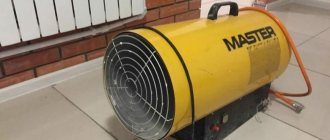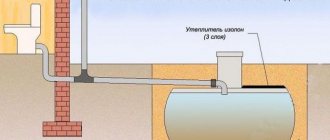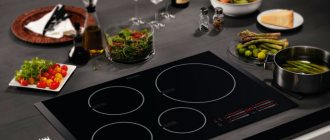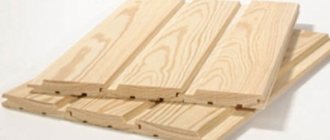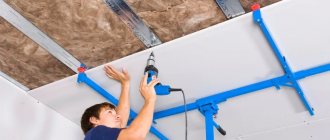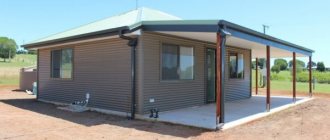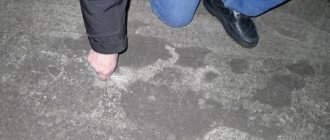Despite all their advantages, conventional oil heaters and convectors are simply not able to quickly warm the air to the required temperature in large rooms. Heat guns cope well with this task. Today there are a wide variety of models on the market. They are widely used for heating warehouses, industrial premises, greenhouses and other large areas. They are also indispensable on open construction sites for creating and maintaining a comfortable temperature in the work area.
No. 1. Operating principle of a heat gun
A heat gun can be considered a large and powerful heat fan, and each of us is probably familiar with the latter. The structure and principle of operation of the gun are quite simple. The body of the device is made of metal that can withstand both mechanical and thermal loads. There are devices in which the body has the shape of a parallelepiped, but often these are cylindrical devices. In fact, thanks to their appearance, the devices began to be called cannons - they look very much like an artillery piece.
The heart of a heat gun is the heating element . This can be a heating element, a spiral, a combustion chamber of liquid or gaseous fuel. Next to the heating element there is a powerful fan, which draws cold air through the holes in the housing and promotes the rapid spread of already heated air. This is such a simple mechanism. There are fanless models that heat surrounding objects using the infrared principle.
Additionally, the device is equipped with a thermostat and a thermostat, which help maintain the set temperature in the room and prevent the device from overheating.
Heat guns can be classified according to several criteria, but the most important difference is the type of fuel used . According to this criterion, heat guns are:
- electrical;
- gas;
- diesel;
- multi-fuel;
- infrared.
Of course, guns also differ in size, power and other parameters, but the very first criterion when choosing is the type of fuel, so let’s start with that.
Which heating gun is better to choose?
When choosing a heat gun to heat a certain room, as when purchasing any other equipment, you should always correlate your needs with the available capabilities. First of all, you need to decide what exactly this device is needed for - for permanent or temporary use, for regular heating of the room or for using the device only for periods.
Heat gun design
In addition to these factors, you will need to consider:
- the size of the room in which the air will need to be heated;
- availability of a particular energy source;
- the presence of ventilation in the room and the possibility of removing combustion products from it;
- permanent or temporary presence of people.
Advice. When choosing the required power of a heat gun, you can base your calculations on approximately the following: 0.8-1.4 kW per 10 sq.m.
To make it easier to understand the most suitable type of device, it is worth taking a closer look at each of the 3 types of guns, assessing the pros and cons of electric, diesel and gas equipment.
No. 2. Electric heat guns
These are the most versatile and easy-to-use devices. A spiral made of refractory metal or a sealed heating element tube is responsible for heating the air. The second option is considered more preferable due to its higher durability and safety. As soon as you plug the gun into the outlet and set the air heating temperature, the fan begins to pump air to the coil or heating element. A stream of warm air comes out of the device, and the room warms up instantly. Using the thermostat, the user can set the maximum permissible heating temperature. When it is reached, the heating will turn off, but the fan will continue to work.
Electricity in such guns is spent both on heating the heating element and on rotating the fan blades. Thermal power ranges from 1.5 to 50 kW . Devices with a power of up to 5 kW can be connected to a regular power supply and used even at home. Most products are equipped with a handle for easy transportation of the device and wheels for greater mobility.
Advantages:
- environmental friendliness. Electric heat guns can be used even in residential unventilated areas, since there are completely no combustion products;
- versatility. The products are suitable for heating garages, auto repair shops, warehouses, greenhouses, cottages, houses, shops, train stations, etc.;
- easy starting at low temperatures, when, for example, liquid fuel analogues require prolonged effort;
- duration of continuous operation and no need to refuel with gas or diesel;
- ease of operation. All you need to do is buy the device and place it in the right place; you don’t have to install a chimney or buy gas cylinders;
- safety.
Minuses:
- electricity is more expensive than gas and diesel, so this type of heating will cost a pretty penny;
- if you need to use a high-power gun, then you need to be connected to a 380 V network and be sure that there are no power outages in the region.
An electric gun is great for quickly heating a cottage, warehouse, office, greenhouse and other premises. As a rule, electrical appliances are used as an additional or backup heat source due to the high cost of operation, but there are exceptions.
Review of the 11 best electric heat guns for the home in 2021
Let's move on to a review of the best guns, consider their characteristics, pros and cons of each specific model. The review is compiled in the form of a rating from 11th place to 1st: this will make it easier for you to decide on the choice of a suitable device for yourself.
Heat guns with a power over 5000 W will not be included in the review, because the high-voltage electrical network necessary for their operation is very rarely found in an apartment or house.
11th place: heat gun ZUBR ZTP-M-Z000 (3 kW)
This Russian brand has gained popularity in the market due to the budget cost of the product. The quality is not the highest level, but if the operating conditions are observed, this heat gun will last a long time.
Electric heat gun BISON ZTP-M1-3000 (3 kW) in the rating of heat guns
The round-shaped case is made of double-layer stainless steel and has compact dimensions. This shape allows you to direct the heat flow to the desired area. It operates on the basis of a tubular electric heater.
When the device is switched on, it creates little noise. Of the minuses, noteworthy is the lack of power and flow temperature regulators. The user does not have the opportunity to smoothly adjust the operating parameters to suit his needs. There are only two fixed operating modes, one of which does not heat the room at all.
Pros:
- low noise level;
- there is a heating element as a heating element;
- reliable ergonomic holder;
- budget cost;
- no overheating of the case.
Minuses:
- there are no regulators for smoothly adjusting the power of the air stream;
- no thermostat;
- only two stationary modes, one of which is useless in practice due to too low power.
Conclusion:
This heat gun is primarily good for its budget price. It will be a good option for quickly heating small rooms.
10th line: electric gun Quattro Elementi QE-2000C
The Italian fan heater is of lower power than the one described earlier, but the performance is no lower. A very worthy choice for heating a room or small studio up to 20 square meters. m.
Electric heat gun Quattro Elementi QE-2000C (2 kW) in the rating of heat guns
It has a round, durable sheet steel body with a stand that allows you to adjust the angle of inclination. The model is compact, weighing about 2 kg. The ventilated flow power regulator is located on the body. There is a function to operate in blowing mode without heating, which will allow you to use this gun in the summer instead of a fan.
The heating element is high-quality ceramic plates. They heat up quickly and maintain comfortable warmth for a long time without drying out the air. The disadvantages include the relatively low power (2 kW).
Pros:
- compactness and lightness;
- heating rate and heat retention time;
- high-quality ceramic heating element;
- flow strength is adjustable;
- budget price;
- Can be used as a fan in summer.
Minuses:
- low-power device: there is a risk that with heating of the declared sq.m. m can't handle it;
- poor functioning of the thermostat;
- can be turned on for 20 hours, then a break is needed.
Conclusion:
The gun is good and can last a long time. Heats well and quickly and is suitable for small areas or as drying equipment for certain purposes.
9th position: “Resanta TEPK-3000K”
This Latvian heater has gained popularity in the market. A round floor-mounted heat gun is good for heating living rooms and garages up to 35 square meters. m, and also as a drying agent during construction and repair work.
Electric heat gun RESANTA TEPK-3000K (3 kW) in the rating of heat guns
Placed on a convenient stand: you can choose the heating direction. Lightweight and compact, but with a durable steel body. There is a mechanical thermostat and a thermostat that triggers when overheating.
A ceramic heater is installed in the gun, due to which heat is saved in the room, and during operation the air does not dry out and there is no burning smell. There is a function of a regular fan.
Pros:
- presence of a thermostat;
- lightness and maneuverability;
- ceramic heater;
- gentle effect on the microclimate;
- mechanical adjustment of heat supply;
- affordable price.
Minuses:
- short power cord wire;
- creates noise during operation.
Conclusion:
The ceramic heating element with all its advantages firmly secures the 9th position for this gun. But there are questions about reliability; it requires compliance with operating rules.
8th stage: Ballu BHP-P-3 heat gun
A good option both for heating homes and for use in warehouses, garages and construction sites. The convenient handle-stand provides mobility and good adjustment of the direction of the device.
Electric heat gun Ballu BHP-P-3 (3 kW) in the rating of heat guns
The steel round body is coated with anti-corrosion impregnation. The heater is a heating element. There is an overheat protection function. After switching off, the inertia of operation continues for another 2 minutes, providing additional heat.
However, it is noticeably noisy during operation.
Pros:
- quality of assembly and materials of the housing and heater;
- gradual heat release;
- The declared heating area is 35 sq. m;
- the cool blowing function allows the gun to be used in summer;
- maneuverability.
Minuses:
- short cord length;
- noisy operation;
- relatively high cost.
Conclusion:
it is a brand that has earned trust in quality, functionality and performance. A good option if you need a heater with a power of up to 3000 W.
7th place: Wester TB-5000 heat gun
Heat gun power – 5000 W. Despite the Chinese components, the device is assembled efficiently and conscientiously. It has a wear-resistant round body, a carrying handle and an ergonomic platform stand.
Electric heat gun Wester TB-5000 (5 kW)
There are mechanical levers for heating and power control, as well as a built-in thermostat and switching to cool ventilation. Although such a fan will be rather weak for the heat.
With the help of such a gun you can warm up to 45-50 sq. m. The main element is the heating element.
Pros:
- high-performance air exchange (400 cubic m/h);
- large heating area;
- high-quality assembly;
- built-in thermostat;
- acceptable price.
Minuses:
- There is a fan function, but the fan itself is weak.
Conclusion:
a good option for long-term continuous operation, allowing high-quality heating of fairly large spaces.
6th position: electric heat gun “Interskol TPE-5”
The domestic heater with a durable cylindrical body has a carrying handle and allows you to adjust and conveniently fix the position of the gun. However, the model is not the most popular, but the point is not in the level of quality, but more in insufficient advertising.
Electric heat gun Interskol TPE-5 (5 kW) in the rating of heat guns
A productive air exchange of 400 cubic meters actively and quickly heats a room of up to 45 square meters. m. There are 2 mechanically adjustable power modes: (3 kW and 4.5-5 kW). The heating element has a well-thought-out engineering design, due to which it does not burn out air. There is simply ventilation and protection against overheating.
The main disadvantage is that there is no power plug included.
Pros:
- good power indicators;
- high heat transfer;
- two-year warranty;
- tilt angle adjustment;
- The heating element does not burn oxygen;
- low noise operation;
- thermostat and fan.
Minuses:
- short wire;
- no power plug included.
Conclusion:
a good heater for those who need to quickly warm up relatively large rooms. And for those who don’t mind the absence of a plug, and who are ready to modify the device after purchase.
5th step: heat gun “Resanta TEPK-5000K”
A cylindrical floor gun with a stand that allows you to adjust the direction of the airflow. 50 kW of power can quickly and efficiently heat up to 50 sq. m working area. There are manual temperature and power controls, a thermostat, and a fan mode.
Electric heat gun RESANTA TEPK-5000K (5 kW) in the rating of heat guns
Ceramic heating plates are installed, which are safe, quiet and maintain indoor air quality.
There are also some downsides: as buyers note in the reviews, the case gets a little hot and the thermostat doesn’t work. However, people recommend it for purchase.
Pros:
- heating rate;
- ceramic heater;
- does not spoil air quality;
- noiselessness.
Minuses:
- after some time of operation, the body of the device heats up;
- unreliable thermostat.
Conclusion: 5th place is well-deserved, but the manufacturer has some work to do. I would like to hope that minor shortcomings will be eliminated and the product will be improved.
4th line: heat gun ELITECH TB 5EK
The top three winners are preceded by a heat gun from a Chinese manufacturer. It has 4.5 kW of power and heats rooms of 45-50 square meters. m. There is a comfortable handle and a stand with tilt angle adjustment. The body is cylindrical.
Electric heat gun ELITECH TV 5EK (4.5 kW) in the rating of heat guns
A stainless steel heating element is installed, which is durable and wear-resistant. A manual thermostat and power regulator are provided. There is a thermostat and a fan. A plug and socket are included.
When overheating, the fan mode turns on. But when cooling to a safe temperature, it does not switch back to heating: this will have to be done manually.
A year warranty is provided.
Pros:
- reliable thermostat;
- high-quality durable heating element made of stainless steel;
- fast heating due to high power;
- silent operation;
- preventing overheating;
- fan function without heat.
Minuses:
- When the thermostat is triggered after cooling to normal, you will have to manually switch the device back to the warm-up mode.
Conclusion:
has many advantages and minor disadvantages. A good heater option.
3rd line: heat gun Ballu BHP-PE-5
A confident third place in the ranking is occupied by an electric heater from Ballu. A lightweight and compact cylindrical gun with a comfortable stand and non-slip handle allows you to select the direction of the heating air flow.
Electric heat gun Ballu BHP-PE-5 (5 kW) in the rating of heat guns
The anti-corrosion coating of the steel body makes the device wear-resistant and durable. There is a protection function against overheating and electric shock. The maximum power is 4.5 kW, due to which the gun easily heats up 50 square meters. m of space.
Built-in stainless steel heating element, manual power and temperature regulators, thermostat with simple fan mode. A two-year warranty is provided.
Pros:
- lightness and maneuverability;
- steel body and stainless steel heating element;
- comfortable thermostat handles;
- reliable thermostat;
- the ability to use it in summer for cool airflow.
Minuses:
- no power plug;
- short network cable.
Conclusion:
An excellent option for a home heater with an optimal price/quality ratio.
2nd position: NeoClima TPK-5 heat gun
Russian device with a power of 5 kW and an air flow of 400 cubic meters per hour. This gun is capable of heating a considerable area (up to 50 square meters). The round steel body and convenient stand allow you to change the angle of the warm air supply.
Electric heat gun NeoClima TPK-5 (4.5 kW) in the rating of heat guns
There is a thermostat protection function and heating intensity adjustment. The heater is a reliable heating element, famous for its durability and good heat retention properties.
The disadvantages include the factory equipment with a plug for a high-voltage network. Therefore, most buyers will have to remake the plug for a standard household voltage network.
Pros:
- high-quality heating element;
- convenient thermostat and adjustable heating;
- ergonomic body design;
- warranty up to two years;
- air supply function without heating.
Minuses:
- noisy work;
- complete with high voltage plug.
Conclusion:
with similar quality parameters to its competitors, the price of this gun is lower, which inclines buyers to prefer this cheaper option. Therefore, a well-deserved second place.
No. 3. Gas heat guns
Gas devices are equipped with a burner with holes through which gas passes into the combustion chamber. When the fuel burns, heat is released, which heats the walls of the heat exchanger. The fan, as in electric guns, forces air to the heat exchanger, releasing it from the gun in a heated form. The fan runs on electricity, so you will still need to connect to an outlet, but the power consumption will be about 30-200 W, so this heating method will have almost no effect on your electricity bills.
A gas heat gun can operate on liquefied cylinder gas or be connected to the gas network. Ignition occurs manually or automatically.
Advantages:
- economical in operation;
- high efficiency;
- rapid heating of large areas and uniform heat distribution;
- For the safety of the user, numerous mechanisms are provided, including overheating protection, a flame control system, etc.
Minuses:
- Even despite all the safety mechanisms, a gas heat gun is more dangerous than an electric one. Combustion uses oxygen, and if the room is not equipped with normal ventilation, then the accumulation of combustion products and a decrease in the amount of oxygen will lead to dire consequences, so get ready to at least occasionally ventilate the room, or organize high-quality ventilation;
- connection to a gas pipeline or constant change of gas cylinders is required.
These disadvantages pale in comparison to the main advantage of gas guns - low operating costs. Devices of this type are usually used for heating large premises: warehouses, workshops, factories, hangars. Gas guns are often used on construction sites when it is necessary for mortars to dry quickly or gain strength, but the room is cool and damp. However, small construction teams and private craftsmen do not have to go broke on purchasing their own equipment - in the cold season, to increase the efficiency of construction, installation and repair work, you can rent a heat gun. In Krasnodar, this service is provided by, which has been selling and renting construction equipment since 2005. The range of gas heat guns can be found on the page https://prof-tech.ru/arenda/teplovye_pushki/gazovye_teplovye_pushki/: all equipment is new and modern, and the company takes on the troubles of maintaining it.
Which manufacturer should you prefer?
In domestic stores of heating equipment, electric guns can be found both imported and manufactured in Russia. In general, there is not much difference between them. Here you need to focus more on the power of the device.
But among the manufacturers there are also recognized leaders, for whose branded fan heaters you will have to overpay a little.
If you need a powerful and durable electric heating gun, then you should pay special attention to models under the brands Ballu (Netherlands) and Master (USA)
Fan heaters are produced by a fairly large number of domestic and foreign companies.
Among the main brands that have won the trust of consumers are:
- Ballu (a Dutch brand, but production is established in Russia);
- Master (USA);
- Timberk (Sweden);
- Inforce (Russia);
- Fubag (Germany);
- Quattro (Italy);
- Tropic (Russia);
- Resanta (Latvia).
Almost all manufacturers offer heat guns in a wide range of heating power and air flow. In the existing range of this equipment, there is always a model for specific needs, you just need to correctly assess the needs.
Taking an electric gun that is too powerful and then turning it off every few minutes so as not to burn yourself is not very smart and costly.
If you want to save money, you can make an electric gun yourself. For assembly you will need a heating element, housing material (metal sheet or pipe), a fan and a motor.
No. 4. Diesel heat guns
Diesel guns, as the name suggests, use diesel as fuel. The design of these devices may vary. There are:
- direct heating diesel guns. They warm up the room faster, as the forced air passes through the combustion chamber. This also leads to a disadvantage - along with the heat, combustion products also enter the room. If there are always people in the room, then such heating is clearly not suitable. This is a good option for heating outdoors, for example, when you need to warm up a car, carry out some construction work on the street, etc.;
- indirectly heated diesel guns . In this case, the fuel, when burned, heats the walls of the chamber, and they already heat the air, which is drawn in by the fan. Combustion products from the chamber are removed through the chimney. This design is safer, but its efficiency is lower.
Otherwise, all diesel guns are designed the same. There is a fan, a combustion chamber and a fuel tank. The latter serves as a container for fuel, from where it is pumped into the combustion chamber. The fuel-air mixture is ignited in the burner thanks to piezo ignition.
Advantages:
- low cost of operation;
- ability to heat large areas;
- devices with a flame control system and a timer can be left unattended.
Minuses:
- the need to monitor the fuel level and constantly top it up;
- the need to provide a chimney or use the device only in open space;
- Over time, the metal in the area near the burner may burn out, so pay attention to the thickness of the metal when purchasing.
Of course, diesel guns are not suitable for residential and public premises. These are, as a rule, large installations that are used for heating warehouses, hangars, industrial premises, and open construction sites.
No. 5. Infrared heat guns
All the heat guns we reviewed earlier have one thing in common – the presence of a fan. It helps to effectively distribute heat throughout the room. Infrared devices work completely differently. They do not have a fan, and heating is carried out due to the fact that the device uses infrared rays to heat the surfaces in the room (floor, walls, furniture), and they, in turn, heat the air. The sun works on the same principle. It turns out that the air warms up much more slowly, but people and objects located in the radiation zone heat up in the very first minutes after turning on the device.
Diesel or kerosene is used as fuel The fuel burns and heats special tubular heating elements, which tend to emit infrared rays when the temperature rises. To prevent the body elements from being heated by the rays, there is a mirror surface behind the heating element. Infrared heat guns are used when spot heating is needed.
Advantages:
- rapid heating of people and objects in the radiation zone;
- almost complete absence of noise, since there is no fan in the design;
- ability to work both outdoors and indoors;
- security and mobility;
- Efficiency up to 95%.
Among the disadvantages are the cost of the equipment and the same spot heating - it will not be possible to quickly warm up the room, as, for example, a gas gun does. This is an excellent solution for rooms with poor thermal insulation, for heating outdoor areas, as well as for repair work.
Advantages and disadvantages of the unit
Among the many advantages of a heat gun operating solely on electricity are the following:
- Possibility of installation in unventilated rooms;
- long period of continuous operation;
- no open fire;
- the presence of control automation with a thermostat;
- receiving heat immediately after connecting to the power grid;
- no need to constantly add combustible fuel;
- the ability to use the gun as a regular fan;
- high efficiency when heating large rooms;
- small dimensions;
- versatility in terms of placement.
The fan heater does not emit unpleasant or harmful substances into the air. There is simply nothing to burn in it. Occasionally, when operating this appliance, a burning smell appears for a short time after power is turned on.
This is due to the accumulation of dust on the heating element and protective grille. If the gun is kept clean, then this will not happen.
You can even heat your home with a fan heater (there are no gas emissions from its operation), problems may arise only with drying the air
The electric heat gun is able to work unattended and continuously for several days. It does not require adding fuel. At the same time, the presence of automation guarantees that the temperature in the room will be maintained at the required parameters without human intervention.
The heating of the spiral, which heats the air in the heat gun, occurs in a matter of seconds after applying electric current. Heat almost immediately begins to flow into the heated room. In this regard, the equipment under consideration greatly outperforms other heater options.
Fan heaters are extremely easy to use. It is only necessary to prevent dust from accumulating inside, which will emit smoke when the coil is turned on. They can be placed on the floor, wall and even on the table. The range of this thermal equipment is extensive. You can find an option for any placement and any size.
The fan heater has only three disadvantages:
- “burning” oxygen and “drying” air;
- high noise level when the fan is turned on to maximum;
- power grid dependence.
When an electric heat gun operates, the air around the heated coil is naturally dried. As a result, the overall humidity in the room gradually drops, and it is impossible to escape.
A similar situation arises with oxygen: it gradually burns out due to the contact of air masses with a hot heating element.
Of course, these are not the same volumes as when operating a gas or diesel gun. But if this moment is critical, then the fan heater should be chosen not with a spiral, but with ceramic plates.
The latter are heated to lower temperatures, which greatly eliminates the disadvantages of open spiral heaters. But such models also cost a little more.
No. 6. Multi-fuel heat guns
Such devices are similar in principle to diesel guns; they can be directly or indirectly heated. An important difference is omnivorousness. You can fill the fuel tank with diesel or kerosene , and some samples are even capable of burning waste oil . Such guns are a real godsend for car repair shops, where a sufficient amount of waste liquids accumulates. They can be recycled while receiving heat. The disadvantages are the same as those of diesel devices, but there are even more advantages if you take into account the ability to work on different types of fuel.
Fuel type
The fuel for gas heat guns is lower saturated hydrocarbons, which are in a gaseous state under normal conditions.
It could be:
- natural gas (methane with a small amount of impurities of heavier hydrocarbons), supplied from a centralized gas main;
- liquefied gas (propane or butane), transported and stored in cylinders.
Gas is cheaper than diesel fuel and significantly cheaper than electricity. Moreover, in this case we are talking about liquefied gas supplied in cylinders; even firewood cannot compete with main gas in terms of cheapness.
Liquid fuel heat guns work equally well on diesel fuel and kerosene. Manufacturers strongly recommend using only these types of fuel. To avoid explosion, fire, and equipment failure, it is strictly prohibited to use alcohol, gasoline, naphtha, or any other flammable liquids to refuel liquid fuel guns.
Exhaust heat guns perfectly “digest” almost any type of liquid oil – motor, transmission, hydraulic, as well as their mixtures. The exceptions are transformer oil and high-viscosity lubricants. Before filling the fuel tank of a heat gun with used oil, it must be cleaned of mechanical particles and water.
And finally, infrared heat guns can operate, depending on the model, on both gas and liquid fuel (kerosene, diesel fuel), as well as electricity. Their fuel quality requirements are the same as those of the corresponding types of heat guns.
When assessing future fuel costs at the stage of choosing a heat gun, you should pay attention to such a characteristic of the heating device as fuel consumption.
No. 7. Thermal power and its calculation
How to compare several different devices in terms of performance? How do you understand that one device is designed to heat small garages, while another can easily warm up a huge warehouse? You need to look at the power indicator, and we are not talking about the electrical power consumed, or rather not always about it. This parameter will be indicative only for electric models. So let's start with them.
The power of electric guns ranges from 1 to 50 kW. It’s difficult to call 1-3 kW models “guns” - they’re more like fan heaters. Let us repeat that devices with a power of up to 5 kW can be connected to a 220 V network. Anything larger is equipment that requires a 380 V network. The most powerful electric guns are devices up to 100 kW.
The power of gas appliances ranges from 10 to 150 kW, but more powerful devices are often found. Diesel and multi-fuel direct heating devices produce all 220 kW, but their indirect heating counterparts have less power - a maximum of 100 kW. Infrared guns are rarely more powerful than 50 kW.
How do you know how much power is needed? Many people advise using an approximate calculation method, according to which 1-1.3 kW of power is sufficient for 1 m2 of space. If the room is low and well insulated, you can multiply by 1 kW, and if there are problems with thermal insulation, then it is better to take the coefficient with a margin.
If you want to get a more accurate result, then arm yourself with a calculator and the following calculation procedure:
- calculate the volume of the room , since this parameter is much more important than the area parameter. If you take a room with an area of 90 m2 and imagine that the ceiling height in it is 4 m, then the volume will be 360 m3;
- temperature difference between the desired indicator indoors (for example, +180C) and the indicator outside the walls. The weather outside in winter can be different. It is usually recommended to take into account the average winter temperature, making allowances for possible frosts. If the gun is the main source of heat, then it is better to take into account the lowest winter temperature. If you are making calculations for a residential building, then choose the comfortable internal temperature yourself. For warehouses, the accepted temperature is +120C, for public buildings - +180C. So, let’s say that in winter there are often frosts down to -200C outside, but inside you need to maintain the temperature at +180C, then the difference will be 380C;
- thermal insulation of the room plays an important role. A special coefficient is taken into account when calculating the power of the gun. If all walls, floor and roof are insulated, the number of windows is small, they have double frames, then k = 0.6-1. If the walls are brick, but without insulation, the roof is standard, and the number of windows is average, then k = 1-2. For structures with a single brick wall and single window frames (garages, for example), the coefficient k = 2-3 is used. For open and semi-open areas, simplified wooden and metal structures without thermal insulation, k = 3-4. Let's say we have a garage with double brick walls without thermal insulation, into which visitors will more or less often enter, then we will assume that k = 1.8;
- Thermal power is calculated using the formula Q = k*V*T. Then we get Q = 1.8*360*38 = 24,624 kcal/h, and since there are 860 kcal/h in 1 kW, it turns out that Q = 24624/860 = 28.6 kW;
- if the gun is not the only source of heat in the room, then this must be taken into account and the power of the existing equipment must be subtracted from the final result;
- You can take more than one high-power gun, but several smaller ones, in order to ultimately obtain the necessary power. If the room has a complex configuration, then several less powerful guns are even better than one more powerful one.
Comparison table of the presented models
After compiling the rating, you have collected all the most necessary characteristics that play a big role when choosing a device. The table of comparative characteristics is presented below.
| Model | Power, kWt) | Voltage (V) | Current (A) | Weight (kg) | Price, rub) |
| Interskol TPE-3 | 3 | 220 | 8.5 | 4.8 | 2 000 – 2 500 |
| Timberk TIH R2 5K | 5 | 220 – 230 | 9 | 6 | 1 900 – 2 100 |
| FUBAG Bora Keramik 20M | 2 | 220 | 8.7 | 2 | 1 800 – 2 400 |
| Shivaki SHIF-EL60Y | 6 | 380 – 400 | 9 | 7.3 | 4 300 – 4 800 |
| Bison ZTP-200_M2 | 2 | 220 | 8 | 5 | 2 000 – 3 000 |
| Ballu BKX-3 | 2.5 | 220 | 9 | 5.6 | 1 500 – 2 200 |
| Interskol TPE-5 | 2 | 220 | 9.1 | 1.7 | 1 800 – 2 400 |
No. 8. Other technical characteristics
To assess whether this or that equipment is suitable for you, you need to analyze a number of additional parameters:
- air flow value, m3/hour. The indicator indicates how well the fan works. Ideally, it should be powerful enough to quickly warm the air around it and prevent overheating of the air directly around the gun. The amount of air flow is the volume of warm air that the device can generate in 1 hour of operation. The higher the power of the gun, the greater the air flow. The indicator ranges from 100-150 to 800 or more m3/hour;
- length of the air stream, m. This indicator also depends on the power of the fan and makes it clear how far the device can send an air stream;
- fuel consumption, kg/h or l/h helps to evaluate the efficiency of the device. It makes sense to compare the parameter with the same power of samples;
- operation noise, dB. All guns that operate thanks to a fan are noisy. The higher the power, the higher the noise level. If compact electric guns produce only 40-50 dB, then large gas and diesel ones can produce 80-90 dB, which will be disturbing in a small room. If noise level is a critical indicator, then it is better to leave the choice on the infrared model;
- duration of work. If the gun is the only source of heat, then it is important that it can work almost around the clock. In the model description you can see something like this 24/1 or 24/2. This means that the device can rest for 1-2 hours per day.
Airflow
The movement of the air mass during operation of the heat gun is carried out by a built-in electric fan. The more efficient the fan, the faster the mixing of warm air with cold air will occur. More powerful heat guns have more efficient fans.
On the one hand, this prevents local overheating of the air in the immediate vicinity of the gun, on the other hand, a powerful device is able to warm up the entire room faster, and this opportunity must be taken advantage of. This leads to another characteristic of a heat gun – air flow.
Air flow (often this characteristic is called the performance of heating ventilation equipment) is the volume of warm air created by a heat gun per hour of operation. Based on the value of this indicator, you can estimate the rate at which the room warms up to the required temperature.
No. 9. Heat gun dimensions
The higher the power of the gun, the larger it will be, which is not surprising. The most compact and mobile are electrical appliances. Household ones weigh from 3 to 5-7 kg, and some industrial ones reach 30 kg. Thanks to the wheels and handle, such devices can be easily moved; the only limitation will be the length of the wire.
Gas guns are also relatively compact and lightweight, and if the fuel source for them is bottled gas, then mobility will be fine. If you use main gas, then any gun will become stationary for some time.
Diesel and multi-fuel guns are considered the largest, since they also have a fuel tank. When it is completely filled with liquid fuel, the weight of the device increases. It is not easy to move a heavy liquid fuel gun, and if a unit with indirect heating is selected, then it is impossible to move the device at all, because it is connected to the chimney.
In special cases, giant heat guns are used, the weight of which amounts to tons. Naturally, such equipment is placed permanently, since even its transportation requires special transport. Mainly used on production sites.
